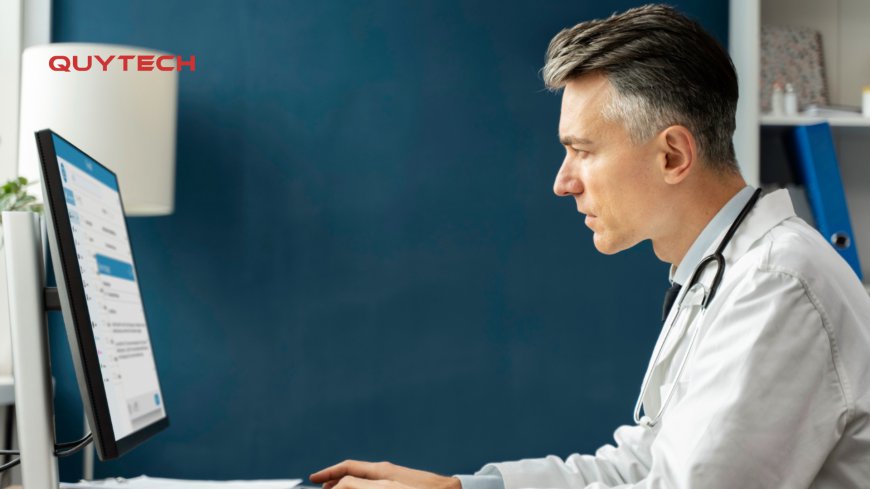Using SaaS to Improve Patient Monitoring | Quytech
SaaS-based Remote Patient Monitoring is revolutionizing how healthcare is delivered, offering numerous benefits such as improved patient outcomes, cost efficiency, and increased access to care.

Remote Patient Monitoring (RPM) has emerged as a game changing tool in healthcare, enabling providers to monitor patients' health outside traditional clinical settings. This shift is largely driven by the advent of Software as a Service (SaaS) solutions, which offer advanced capabilities for managing and analyzing health data remotely.
In this blog, we’ll explore how SaaS is enhancing RPM and ultimately improving patient outcomes.
What is Remote Patient Monitoring?
Remote Patient Monitoring refers to the use of technology to collect health data from patients in real-time, typically from their homes. This data will be transmitted to healthcare providers for analysis and intervention. RPM systems can track various health metrics, including blood pressure, glucose levels, heart rate, and more. The goal is to provide continuous monitoring without the need for frequent in-person visits.
The Role of SaaS in Remote Patient Monitoring
1. Seamless Data Integration SaaS platforms offer seamless integration with various health monitoring devices, allowing for the continuous collection and centralization of patient data. This integration ensures that all relevant information is accessible in one place, facilitating comprehensive monitoring and analysis.
2. Real-Time Data Access One of the key advantages of SaaS-based RPM systems is real-time data access. Healthcare providers can monitor patient metrics as they are collected, enabling timely interventions and adjustments to treatment plans. This immediacy is crucial for managing chronic conditions and preventing complications.
3. Scalability and Flexibility SaaS solutions provide the scalability and flexibility needed to adapt to the growing demands of RPM. Whether an organization needs to add new devices, expand to additional patients, or integrate new features, SaaS platforms can easily accommodate these changes without significant infrastructure investments.
4. Enhanced Patient Engagement SaaS platforms often come with patient-facing applications that empower individuals to actively participate in their health management. Features such as personalized alerts, health tracking, and educational resources help patients stay informed and engaged with their care.
Benefits of SaaS-Based Remote Patient Monitoring
1. Improved Patient Outcomes By enabling continuous monitoring, SaaS-based RPM systems can significantly improve patient outcomes. Timely data allows healthcare providers to detect issues early, adjust treatment plans proactively, and avoid hospitalizations. For chronic conditions like diabetes or hypertension, regular monitoring helps in maintaining optimal health levels.
2. Cost Efficiency RPM reduces the need for frequent office visits, which can lower healthcare costs for both providers and patients. By leveraging SaaS solutions, organizations can minimize the costs associated with maintaining on-premises infrastructure and focus on delivering high-quality care.
3. Increased Access to Care SaaS-based RPM extends the reach of healthcare services, particularly in underserved or remote areas. Patients who may not have easy access to healthcare facilities can benefit from regular monitoring and timely care without the need for travel.
4. Data-Driven Insights The data collected through SaaS RPM systems provides valuable insights into patient health trends and treatment effectiveness. Healthcare providers can use these insights to make informed decisions, refine care strategies, and improve overall care quality.
Challenges of SaaS-Based Remote Patient Monitoring
1. Data Security and Privacy Handling sensitive health information requires robust data security measures. SaaS providers must ensure compliance with regulations such as HIPAA to protect patient data from unauthorized access and breaches. Choosing a reliable healthcare app development company or SaaS development company is crucial for maintaining data security.
2. Technology Adoption Both patients and healthcare providers must be comfortable with the technology used in RPM systems. Training and support are essential to ensure that all users can effectively utilize the tools and understand the data being collected.
3. Integration with Existing Systems Integrating SaaS RPM solutions with existing electronic health records (EHR) and other healthcare systems can be complex. Ensuring seamless data flow between systems is necessary to avoid discrepancies and enhance the efficiency of care.
4. Technical Issues Technical problems such as connectivity issues or software glitches can impact the effectiveness of RPM systems. Healthcare organizations need to have contingency plans in place to address these issues promptly and minimize disruptions in patient care.
Future Trends in Remote Patient Monitoring
The future of RPM is poised for significant advancements, driven by innovations in technology and data analytics. Here are some trends to watch:
1. Advanced Analytics and AI Artificial intelligence and advanced analytics are set to play a crucial role in RPM. AI algorithms can analyze complex health data, identify patterns, and predict potential health issues before they become critical, allowing for more proactive care.
2. Integration with Wearable Devices Wearable technology, such as smartwatches and fitness trackers, is becoming increasingly integrated with RPM systems. These devices provide continuous health data and can be used to monitor a wide range of metrics in real-time.
3. Personalized Health Management Future RPM solutions will likely offer more personalized health management features, tailoring interventions and recommendations based on individual patient data and preferences.
4. Enhanced Patient Experience Improving the patient experience will be a key focus, with advancements in user-friendly interfaces, real-time communication features, and personalized health insights contributing to better engagement and satisfaction.
Conclusion
SaaS-based Remote Patient Monitoring is revolutionizing how healthcare is delivered, offering numerous benefits such as improved patient outcomes, cost efficiency, and increased access to care. Despite challenges related to data security, technology adoption, and system integration, the potential of SaaS in enhancing RPM is significant.
Partnering with SaaS development services can help healthcare organizations navigate these challenges and optimize their RPM systems. As technology continues to evolve, SaaS-based RPM will play a pivotal role in shaping the future of patient care.
